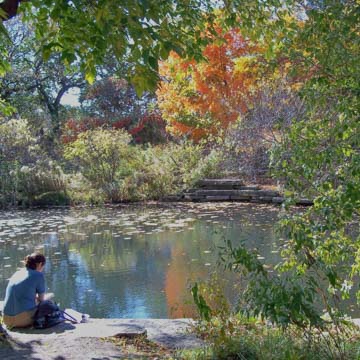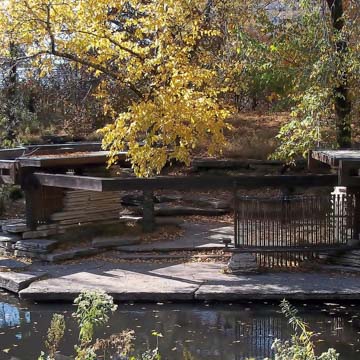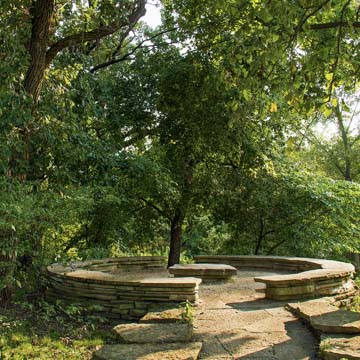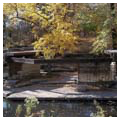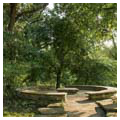The Lily Pool in Chicago’s Lincoln Park embodies early-twentieth-century architectural and garden design trends in the Midwest. Commissioned in the 1930s and designed by Alfred Caldwell, the Lily Pool sits in the middle of Chicago’s largest park, a small, public space that provides respite from the bustling Chicago Loop. Indeed, Caldwell described the Lily Pool as “a hidden garden for the people of Megalopolis,” including those “without hope of escape in Buicks.” It features an extensive planting palette of Midwestern native plants, stone paths, a lagoon, stone outcroppings, pavilions, waterfall, and council ring—a masterpiece of Prairie Style landscape design.
Prior to construction of the Lily Pool, the site was a natural lowland situated between sand dunes. In 1889, the area was occupied by a small Victorian pool used for the cultivation of tropical water lilies, but had fallen into disrepair by the time Caldwell began working for the Chicago Parks District in 1936. During his tenure (1936–1941), Caldwell’s approach to design was adopted throughout the Park System, frequently characterized with phrases like the “Illinois way of planting,” “naturalistic effects,” and “prairie style.” Caldwell was influenced by prominent Midwestern designers of an earlier generation, including Jens Jensen, who was his teacher, and Frank Lloyd Wright. Many architectural motifs at the Lily Pond are characteristic of Wright’s work, such as the emphasis on horizontality, flat rooftops, strong craftsmanship, and restrained ornamentation. The subtle Japanese influence evident in Caldwell’s work is also attributed to his relationship with Wright. Caldwell’s adoption of Prairie Style landscape design reflects his training with Jensen. Like Jensen, Caldwell favored a primarily native plant palette, symbolic of pre-settlement Illinois. Similarly, the Lily Pool’s council ring utilizes an element central to many of Jensen’s designs, and intended to provide an egalitarian gathering space.
Caldwell’s inspiration for the Lily Pool came directly from the park’s topography, which was carved by the movement of the Late Wisconsin Glacier. In a 1942 essay on the Lily Pool, Caldwell writes romantically of the natural architecture of the Midwestern landscape, where “stones of the prairie are sweeter than the mountains, comprehensible and human.” That passion was evident in every aspect of the Lily Pool, as Caldwell put his heart and soul into the project. When the City Parks District refused to purchase wildflowers for planting the site, Caldwell famously cashed out his life insurance plan for $300 and drove to northern Wisconsin to purchase and collect the materials.
Over the years, pedestrian foot traffic, the overgrowth of aggressive plant species, and inadvertent destruction caused by a nearby bird sanctuary, took their toll on Caldwell’s lovely escape. Restoration efforts took place in the 1960s, but the deterioration continued and by the 1990s the Lily Pool was in need of serious repair.
In 2000, the friends of Lincoln Park and the Chicago Park District led a $2.4 million restoration. Landscape architects Wolff Clements and Associates provided restoration design services and a series of ADA-compliant site improvements. Funders for the project included the U.S. Forest Service, the Chicago Community Trust, the Illinois FIRST program, and the Graham Foundation. The removal of several invasive trees and shrubs opened up of the canopy layer and increased the diversity of the groundcovers below. Many of the indigenous species from Caldwell’s original scheme were reinstalled to recreate a woodland glade as the designer intended. The council ring, paths, waterfall, and ledges, composed of Niagara limestone, were also restored. Two Prairie Style pavilions were also restored, and a half-acre of bird habitat was added to the site to minimize stress on the environment.
Today, the Lily Pool is exceptional not only for its human-oriented uses, but also for its ecological functions as it provides critical habitat for migratory and nesting birds. USDA research scientist Paul Gobster describes the Lily Pool as a hybrid landscape, coupling critical ecological restoration goals with cultural objectives, and he sees it as a model for approaching restoration work in natural areas. There is a strong diversity in the plantings: a mix of aged canopy trees, understory, and mid-story forbs, grasses, and shrubs, and aquatic species. In 2002, the Lily Pool was recognized as a Chicago Landmark, and in 2006 was designated a National Historic Landmark. Today, acclaimed docent and educational programs are part of ongoing efforts to maintain and preserve this diverse landscape.
References
Bachrach, Julia. “The Alfred Caldwell Lily Pool: a Prairie Style Haven.” Vineyard6 (2005): 1, 13-15.
Gobster, Paul H. “Alternative Approaches to Urban Natural Areas Restoration: Integrating Social and Ecological Goals.” Forest Landscape Restoration15 (2012): 155-176.
Seeger, Nancy. “Pooling Their Efforts.” Parks & Recreation38, no. 1 (2003): 71.
Tishler, William H. “Conservation Pioneers: Jens Jensen and the Friends of Our Native Landscape.” Wisconsin Magazine of History86, no. 4 (2003): 2-15.














